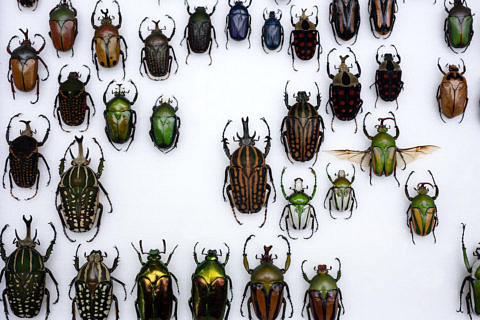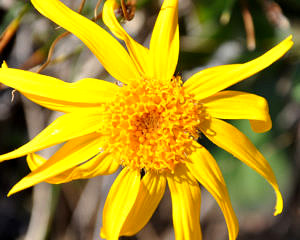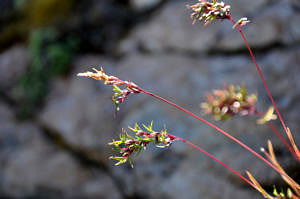On the brink

Is the increasing diversity of species on mountain summits a worrying development?
Climate change is threatening species diversity, a new mass extinction may be approaching. At the same time, some regions are actually experiencing an increase in species diversity. Is everything not as bad as we’ve been led to believe after all?
By Roland Knauer
The ‘deadly trio’ has left a trail of destruction in its wake several times already. They struck with particular vehemence not once but twice in a short space of time approximately 252 million years ago. At that time, the terrible threesome wiped out 90 percent of all species in the oceans, causing similar death and destruction on land as well. They struck once again approximately 200 million years ago, before returning 180 million years ago – and evidence suggests that the deadly trio are stirring again. It is not the police who are hot on the heels of the offenders, however, but rather palaeontologists such as Wolfgang Kießling from the Chair for Palaeoenvironmental Research at FAU. After all, the members of the trio are not living beings, they are forces of nature.
The deadly trio
‘The deadly trio always follows a similar pattern,’ explains Wolfgang Kießling. 252 million years ago, huge lava flows erupted from the earth in the area we know today as Siberia. These flood basalts still cover an area of two million square metres today, in other words an area approximately half the size of the European Union. Unbelievably large volumes of magma were expelled from the Earth’s crust in some areas, leading to layers of basalt towering nearly 3000 metres high. Together with the lava, huge quantities of the greenhouse gas carbon dioxide were released into the air. However, the volcanic gases alone are not enough to explain the global warming of approximately 15 degrees Celsius over a period of one million years experienced at that time. The lava flows probably also ignited layers of coal, mineral oil, gas and peat lying beneath the earth, which released more carbon dioxide as they burned. In addition, rising water temperatures heated up ‘methane clathrates’. These clathrates remain solid and stable on the ocean floor at lower temperatures, but if temperatures rise, they begin to lose methane gas, a much more powerful greenhouse gas than carbon dioxide, which drives temperatures up further. As a result, temperatures rise even more, even more methane is set free, which heats the climate up even further – a vicious circle is set in motion. These rising temperatures are the first component of the deadly trio.

The carbon dioxide which is released dissolves in water and makes the ocean more acidic. However, certain organisms such as coral and many others besides react extremely sensitively to the acidification of the oceans, as they find it difficult, if not impossible, to form their protective calcareous shell or skeleton in acidic water. Acidification of the oceans is number two in the deadly trio. Those groups of animals who form thick calcareous skeletons were the ones which suffered particularly badly 252 million years ago; ancient corals were effectively wiped out.
‘The situation is aggravated by the fact that considerably less oxygen dissolves in warmer waters compared to cooler waters,’ explains Wolfgang Kießling. This poses a problem for marine animals, as they cannot live without oxygen. A depletion of oxygen is therefore number three in the deadly trio. The three deadly forces are at work again today, using exactly the same mechanisms as before. Again, events are being triggered by an increase in carbon dioxide in the atmosphere. Nowadays, however, this greenhouse gas is not coming from volcanoes, but from industrial chimneys, oil heating and car exhaust pipes. Wolfgang Kießling and his colleagues have every reason to investigate the climate change that took place many millions of years ago in more detail.
Just like detectives who are trying to track down a cunning serial offender, palaeontologists use the most hi-tech methods they have at their disposal. One of these is based on the heavy metal mercury, which is only very rarely released from natural sources. One exception to this rule is during volcanic eruptions, when it is released in measurable quantities. If researchers find increased quantities of mercury in a layer of stone, this is an indication that volcanoes were active during the period in which the layer was created. Comparing the layers directly above and below the layer with the higher levels of mercury allows scientists to draw conclusions about the effects of volcanic activity. If researchers find a wide variety of organisms in the layer created directly before the eruption which are then missing in the layer created after the eruption, this indicates that the volcanoes and the greenhouse gases they released contributed to the extinction event.
Wolfgang Kießling and his colleagues are pursuing several other paths to shed light on what exactly happened. How much carbon dioxide was in the air anyway at that time, how much was added, and how did the temperatures in the oceans change? As so much time has passed since the extinction event, the researchers have no choice but to base their assumptions on any clues they can find. Some of the clues lead back to the deadly trio, others simply peter out. There is virtually nothing, however, which disputes the theory that the death and destruction was caused by the deadly trio, and incited by the massive increase in greenhouse gases.
Shrinking shells
According to Wolfgang Kießling, one central aspect of their research is as follows: ‘We are not only interested in how extinction came about, we would also like to find out whether there were any signs that it was approaching, and if there is any indication that the deadly trio is on the warpath again today.’ Researchers made a very interesting discovery in this context. Biologists have been aware for a long time that animals in cold regions grow larger than in warmer climes. In the case of bears, for example, the heaviest bears – polar bears – live in the far north, and the same is true for many other groups of animals. Wolfgang Kießling and his colleagues discovered that the same applied in reverse to ammonites, members of the cephalopod family like the squids found in the oceans today, but with a protective calcareous shell. Before the volcanoes in the area now known as Siberia erupted, these calcareous shells were on average roughly 15 centimetres in size.
The more ferociously the deadly trio attacked and the higher the temperatures climbed, the fewer nutrients there were in the water. Evolution responded accordingly: ammonites became smaller and smaller, ending up at an average size of just three centimetres. Shortly thereafter, in the largest extinction event discovered by researchers so far, the previously huge variety of ammonites disappeared entirely. To give an idea of scale, if this Liliput effect were transferred to a person who is 175cm tall, they would shrink to the size of a kitten.

Whilst dwarfing of such a scale may appear unimaginable, researchers have already been able to observe that species in the oceans are shrinking as a result of climate change today. And they have observed another clear reaction to the rising temperatures: many species in the oceans are migrating towards the poles, in search of cooler waters.
On land, there has not yet been such clear evidence of migration towards the poles. However, researchers have observed that plants are being found higher and higher up mountains. Over one hundred years ago, botanists drew up records showing exactly which plants were growing where. Nowadays, these records can help researchers trace any changes being caused by climate change. However, researchers in the 21st century often find it hard to locate the exact spot which is meant. At the time the records were drawn up, satellite positioning systems such as GPS had not been invented and important orientation markers such as crossings or milestones have changed over the years.
Increased diversity of species on mountain tops
Ecologist Manuel Steinbauer and his colleagues in eleven European countries have therefore concentrated their research on locations which they are able to pinpoint exactly more than one hundred years after they were first investigated. The FAU professor for System Palaeobiology explains that the major advantage of landmarks such as these for studies like the one in question is that ‘the summits of mountains are defined precisely.’
The researchers climbed 302 summits in the Alps, the Pyrenees, the Carpathian Mountains, the North of Norway and the Scottish Highlands, where their colleagues in the previous century had meticulously recorded all species of plant they found there, and repeated the survey. At first glance, their results seem to contradict any suggestion of extinction caused by climate change. In 1835, for example, just one single plant was found growing on the Piz Linard summit in the Rhaetian Alps in Switzerland: a solitary Alpine rock jasmine defied the icy temperatures and whistling winds at these heights. Today, however, Sonja Wipf from the WSL Institute for Snow and Avalanche Research (SLF) in Davos in Switzerland has recorded 16 different species. It is particularly noticeable that plants which have never previously been observed at such heights have started to appear on Piz Linard over the course of the last few decades. This would of course suggest that climate change is behind this increase in plant diversity.
The situation in other locations is similar: researchers recorded more species than before on 86 percent of the 302 summits investigated. In the last fifty years, this increase in diversity has greatly accelerated. Whilst an average of 1.1 new species were recorded on each of the summits in the decade from 1957 to 1966, between 2007 and 2016 researchers already counted an average increase of 5.5 species.
At first glance, this increase in species diversity on mountain summits does not appear to be a bad thing. For Martin Steinbauer and his colleagues, however, it is rather alarming, indicating the increased speed at which climate change initiated by the human race is affecting nature. Not only that, the new plants are species which are common in lower elevations. This means that there is at first no real change to species diversity. It is to be expected, however, that over time at least some of the plants which have grown at the summits to date will be forced out by the new species, which are better used to the higher temperatures we are experiencing today. Plants will be forced into competition with each other, and the plants previously found at the summit will be in a weaker position. In the long term, they may even disappear altogether. As the plants originally found at the summit are often species which are only found there and have no, or at least very restricted, options for making way and moving into higher elevations, a loss of traditional vegetation would lead to a reduction in species diversity. The increase in the diversity of species observed today on certain mountain summits may just be a harbinger of future changes in the wake of climate change.
friedrich – FAU´s research magazine

This article was originally published in our research magazine friedrich. The current issue deals with all aspects of the topic of ‘End’: which of them are unavoidable? How do people deal with this? What does it mean for individuals? Is what people define as the end really the end? Sometimes things just change or develop and something new is created. Occasionally, the end is not an issue at all, with the human race striving for eternity. Is it possible for us to understand this term at all? Is innovation infinite? And do we live forever – on the Internet?
Download friedrich 118 (in German language)
More articles from the magazine can be found under the keyword ‘friedrich’.